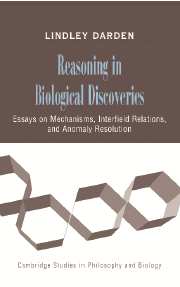 Reasoning in Biological Discoveries
Reasoning in Biological Discoveries Book contents
- Frontmatter
- Contents
- Long Contents
- List of Figures
- List of Tables
- Acknowledgments
- Introduction
- PART I BIOLOGICAL MECHANISMS
- PART II REASONING STRATEGIES: RELATING FIELDS, RESOLVING ANOMALIES
- 5 Interfield Theories with Nancy Maull
- 6 Theory Construction in Genetics
- 7 Relations Among Fields in the Evolutionary Synthesis
- 8 Selection Type Theories with Joseph A. Cain
- 9 Strategies for Anomaly Resolution: Diagnosis and Redesign
- 10 Exemplars, Abstractions, and Anomalies: Representations and Theory Change in Mendelian and Molecular Genetics
- 11 Strategies for Anomaly Resolution in the Case of Adaptive Mutation
- PART III DISCOVERING MECHANISMS: CONSTRUCTION, EVALUATION, REVISION
- Bibliography
- Index
- References
11 - Strategies for Anomaly Resolution in the Case of Adaptive Mutation
Published online by Cambridge University Press: 31 August 2009
- Frontmatter
- Contents
- Long Contents
- List of Figures
- List of Tables
- Acknowledgments
- Introduction
- PART I BIOLOGICAL MECHANISMS
- PART II REASONING STRATEGIES: RELATING FIELDS, RESOLVING ANOMALIES
- 5 Interfield Theories with Nancy Maull
- 6 Theory Construction in Genetics
- 7 Relations Among Fields in the Evolutionary Synthesis
- 8 Selection Type Theories with Joseph A. Cain
- 9 Strategies for Anomaly Resolution: Diagnosis and Redesign
- 10 Exemplars, Abstractions, and Anomalies: Representations and Theory Change in Mendelian and Molecular Genetics
- 11 Strategies for Anomaly Resolution in the Case of Adaptive Mutation
- PART III DISCOVERING MECHANISMS: CONSTRUCTION, EVALUATION, REVISION
- Bibliography
- Index
- References
Summary
INTRODUCTION
Anomalies often challenge biological generalizations. Among the generalizations of widest scope in biology are natural selection and the central dogma of molecular biology. Because natural selection often produces novel variants, it might be expected that wide-scope generalizations would be infrequent (other than the theory of natural selection itself). Furthermore, biological regularities are evolutionarily contingent (Beatty 1995); whatever regularity has evolved can evolve away. Nonetheless, the central dogma of molecular biology is one of the most general findings in all of biology. It provides a schema for protein synthesis that involves unidirectional information flow from nucleic acids to proteins but not back. If information does not flow back into the genetic material, then there seems to be no mechanism for the inheritance of adaptive acquired characters. Although adaptive characters might be acquired during the life of one organism, their inheritance requires a change in the genetic material passed to the next generation. Because NeoLamarckian mechanisms require such inheritance, the lack of backwards flow of information strengthens the case for NeoDarwinian natural selection as the account of adaptations against any version of NeoLamarckism. The contemporary NeoDarwinian theory of natural selection claims that mutations arise spontaneously; that is, they are produced independently of their fitness in a given environment.
Anomalies challenging generalizations of such wide scope get attention. In a paper in 1988, John Cairns and colleagues claimed to find a new class of mutations in bacteria, called “directed mutations” and later “adaptive mutations.”
Information
- Type
- Chapter
- Information
- Reasoning in Biological DiscoveriesEssays on Mechanisms, Interfield Relations, and Anomaly Resolution, pp. 248 - 268Publisher: Cambridge University PressPrint publication year: 2006